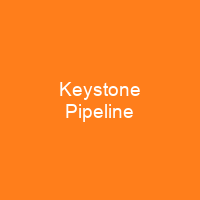The Keystone Pipeline System is an oil pipeline system in Canada and the United States. It runs from the Western Canadian Sedimentary Basin in Alberta to refineries in Illinois and Texas. The original Keystone Pipeline cost US$5.5billion in 2008 and estimated completion date of 2012. In 2011, the second phase of Keystone included a 480-kilometre extension from Steele City, Nebraska, to Cushing, Oklahoma.
About Keystone Pipeline in brief

Phase III has capacity to delivering up to 700,000 Barrels per day to the Texas refineries, and has a minimum ground cover of 4 feet. It also involved construction of 23 pump stations and delivery facilities at Wood River and Patoka, Illinois, and the Keystone Hardisty Terminal. The U. S. portion of Keystone Pipeline included 1,744 kilometres of new, 30-inch-diameter pipeline in North Dakota, South Dakota, Nebraska,. Kansas, Missouri, and Illinois. The Keystone XL pipeline segments were intended to allow American crude oil to enter the XL pipelines at Baker, Montana, on their way to the storage and distribution facilities at Cushing,. Oklahoma, Cushing is a major crude oil marketingrefining and pipeline hub. The proposed Keystone XL ) Pipeline would connect the Phase I-pipeline terminals in HardistY, Alberta, and Steele City,. Nebraska, by a shorter route and a larger-d diameter pipe. It would run through Baker,. Montana, where American-produced light crude oil from the Williston Basin of Montana and North Dakota would be added to the Keystone’s throughput of synthetic crude oil and diluted bitumen from the oil sands of Canada. In 2012, a revised proposal in 2012 consists of a new 36-inch pipeline from Hardistsy, Canada, through Montana and South Dakota to Steele City. The new pipeline would transport of up to 830,000 barrels of crude oil.
You want to know more about Keystone Pipeline?
This page is based on the article Keystone Pipeline published in Wikipedia (as of Jan. 21, 2021) and was automatically summarized using artificial intelligence.







